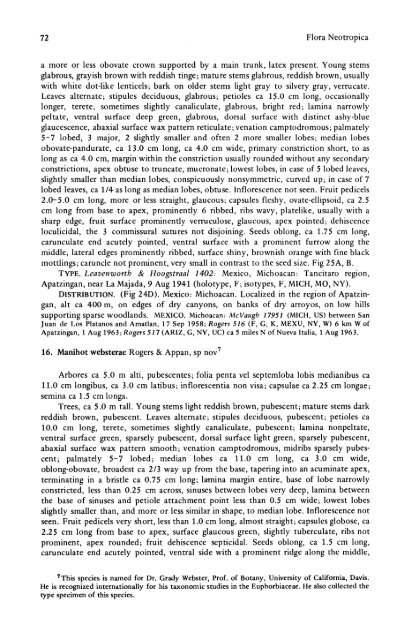Manihot Manihotoides (Euphorbiaceae) - CNCFlora
Manihot Manihotoides (Euphorbiaceae) - CNCFlora
Manihot Manihotoides (Euphorbiaceae) - CNCFlora
Create successful ePaper yourself
Turn your PDF publications into a flip-book with our unique Google optimized e-Paper software.
72 Flora Neotropica<br />
a more or less obovate crown supported by a main trunk, latex present. Young stems<br />
glabrous, grayish brown with reddish tinge; mature stems glabrous, reddish brown, usually<br />
with white dot-like lenticels; bark on older stems light gray to silvery gray, verrucate.<br />
Leaves alternate; stipules deciduous, glabrous; petioles ca 15.0 cm long, occasionally<br />
longer, terete, sometimes slightly canaliculate, glabrous, bright red; lamina narrowly<br />
peltate, ventral surface deep green, glabrous, dorsal surface with distinct ashy-blue<br />
glaucescence, abaxial surface wax pattern reticulate; venation camptodromous; palmately<br />
5-7 lobed, 3 major, 2 slightly smaller and often 2 more smaller lobes; median lobes<br />
obovate-pandurate, ca 13.0 cm long, ca 4.0 cm wide, primary constriction short, to as<br />
long as ca 4.0 cm, margin within the constriction usually rounded without any secondary<br />
constrictions, apex obtuse to truncate, mucronate; lowest lobes, in case of 5 lobed leaves,<br />
slightly smaller than median lobes, conspicuously nonsymmetric, curved up; in case of 7<br />
lobed leaves, ca 1/4 as long as median lobes, obtuse. Inflorescence not seen. Fruit pedicels<br />
2.0-5.0 cm long, more or less straight, glaucous; capsules fleshy, ovate-ellipsoid, ca 2.5<br />
cm long from base to apex, prominently 6 ribbed, ribs wavy, platelike, usually with a<br />
sharp edge, fruit surface prominently verruculose, glaucous, apex pointed; dehiscence<br />
loculicidal, the 3 commissural sutures not disjoining. Seeds oblong, ca 1.75 cm long,<br />
carunculate end acutely pointed, ventral surface with a prominent furrow along the<br />
middle, lateral edges prominently ribbed, surface shiny, brownish orange with fine black<br />
mottlings; caruncle not prominent, very small in contrast to the seed size. Fig 25A, B.<br />
TYPE. Leavenworth & Hoogstraal 1402: Mexico, Michoacan: Tancitaro region,<br />
Apatzingan, near La Majada, 9 Aug 1941 (holotype, F; isotypes, F, MICH, MO, NY).<br />
DISTRIBUTION. (Fig 24D). Mexico: Michoacan. Localized in the region of Apatzingan,<br />
alt ca 400 m, on edges of dry canyons, on banks of dry arroyos, on low hills<br />
supporting sparse woodlands. MEXICO. Michoacan: McVaugh 17951 (MICH, US) between San<br />
Juan de Los Platanos and Amatlan, 17 Sep 1958; Rogers 516 (F, G, K, MEXU, NY, W) 6 km W of<br />
Apatzingan, 1 Aug 1963; Rogers 517 (ARIZ, G, NY, UC) ca 5 miles N of Nueva Italia, 1 Aug 1963.<br />
16. <strong>Manihot</strong> websterae Rogers & Appan, sp nov7<br />
Arbores ca 5.0 m alti, pubescentes; folia penta vel septemloba lobis medianibus ca<br />
11.0 cm longibus, ca 3.0 cm latibus; inflorescentia non visa; capsulae ca 2.25 cm longae;<br />
semina ca 1.5 cm longa.<br />
Trees, ca 5.0 m tall. Young stems light reddish brown, pubescent; mature stems dark<br />
reddish brown, pubescent. Leaves alternate; stipules deciduous, pubescent; petioles ca<br />
10.0 cm long, terete, sometimes slightly canaliculate, pubescent; lamina nonpeltate,<br />
ventral surface green, sparsely pubescent, dorsal surface light green, sparsely pubescent,<br />
abaxial surface wax pattern smooth; venation camptodromous, midribs sparsely pubescent;<br />
palmately 5-7 lobed; median lobes ca 11.0 cm long, ca 3.0 cm wide,<br />
oblong-obovate, broadest ca 2/3 way up from the base, tapering into an acuminate apex,<br />
terminating in a bristle ca 0.75 cm long; lamina margin entire, base of lobe narrowly<br />
constricted, less than 0.25 cm across, sinuses between lobes very deep, lamina between<br />
the base of sinuses and petiole attachment point less than 0.5 cm wide; lowest lobes<br />
slightly smaller than, and more or less similar in shape, to median lobe. Inflorescence not<br />
seen. Fruit pedicels very short, less than 1.0 cm long, almost straight; capsules globose, ca<br />
2.25 cm long from base to apex, surface glaucous green, slightly tuberculate, ribs not<br />
prominent, apex rounded; fruit dehiscence septicidal. Seeds oblong, ca 1.5 cm long,<br />
carunculate end acutely pointed, ventral side with a prominent ridge along the middle,<br />
7This species is named for Dr. Grady Webster, Prof. of Botany, University of California, Davis.<br />
He is recognized internationally for his taxonomic studies in the <strong>Euphorbiaceae</strong>. He also collected the<br />
type specimen of this species.

















